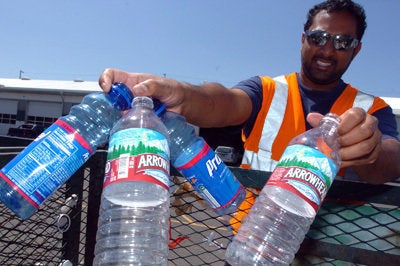
Sometimes when you're buying the latest eco-gear, you'll see that it brags about being made of "PET." What's PET, you ask? The short answer is that it's recycled plastic. The long answer?
Polyethylene terephthalate, commonly abbreviated PET, is a thermoplastic polymer resin of the polyester family. It is most often used in synthetic fibers, as a material for plastic bottles and food containers, in thermoforming applications, and in engineering resins often in combination with glass fiber. Essentially, it is extremely versatile and is one of the most useful and important raw ingredients in man-made fibers.
According to The New York Times' Alina Tugend,
The type of plastic bottle that typically holds water, soda and juice is made from polyethylene terephthalate, a petroleum-based material also known as PET that is labeled No. 1. "The trouble with reusing those plastic bottles is that each time they are washed and refilled they become a little more scratched and crinkly, which can lead them to degrade. That can cause a trace metal called antimony to leach out," said Frederick S. vom Saal, a professor of biology at the University of Missouri who has studied plastics for years.
Indeed, although all plastic containers bear the arrow-triangle symbol with a number (1-7) in the middle, suggesting they are all recyclable, only numbers 1 and 2 can be recycled. PET is the most recyclable plastic, and is increasingly being made into a diverse array of products.
Reusable Bags reports:
In the late 1970s, only a few years after PET entered the United States marketplace, forward-thinking companies found the means to transform recycled PET into many useful products - the most common being packaging (such as new bottles) and fiber (carpet and other textile) applications. Other companies followed suit, and by the late 1990s were finding uses for over 1/2 billion pounds of recycled PET per year. Products made of Recycled PET include blankets, belts, shoes, insulation, and even car parts. As demand increases, and as new applications for Recycled PET are discovered, the marketplace will foster more incentives for consumers to recycle PET.
Design Boom concurs:
PET can be recycled into fibres that are used for polyester fabrics. Major designers used recycled plastic bottles for haute couture. Five PET bottles yield enough fiber for one extra-large t-shirt or twenty-five two-liter bottles can make one sweater. Five two-liter PET bottles yield enough fiberfill for a ski jacket. PET is also spun like cotton candy to make fiber filling for pillows and quilts.
Treehugger's Karin Kloosterman reported last spring that Bagir has crafted the world's first suit made from recycled PET bottles. The $200 a suit - which is available at Marks and Spenser - "is made from wool and recycled PET plastic bottles collected in Japan."
Treehugger also recently featured the work of artist Miwa Koizumi:
The series she entitles "PET project" is a clever collection of #1 plastic bottles (Polyethylene terephthalate, better known as PET) recycled and melted, cut and otherwise altered to look like sea creatures, mostly jellyfish. Says the artist, "I love the idea of using liquid containers to make water animals. Contained/containing, trash/not-trash, like the jelly-fish or anemone: Living/non-living. And I wanted some pets...I have as much material as I want just by fishing in the garbage." While it is a cool way to reuse some old San Pellegrino water bottles and the like, the real charm of the project is the trash-to-art process, and though it's fairly easy to see that the new jellyfish is really old plastic, it's cool enough to not really matter.